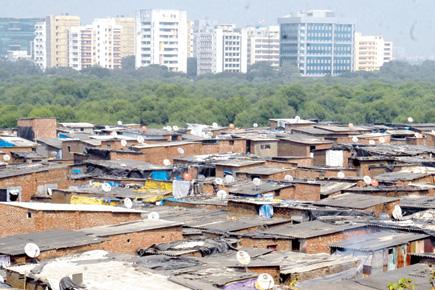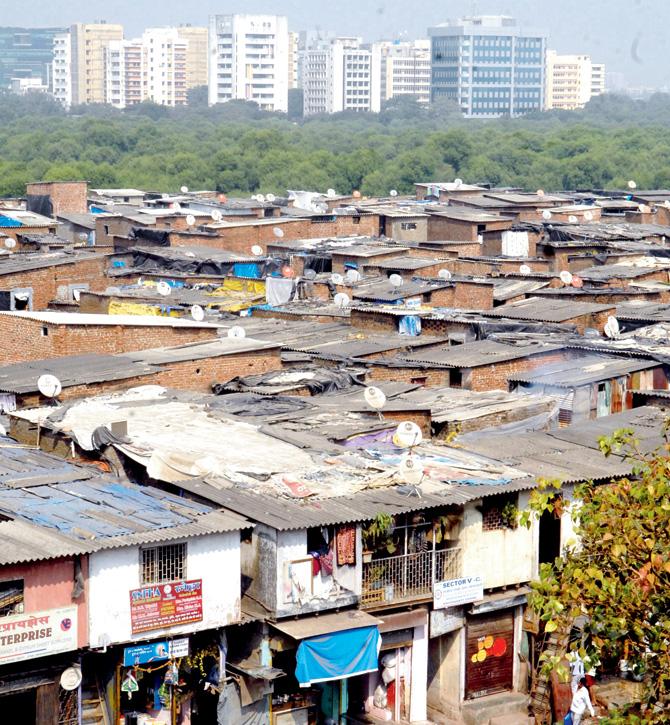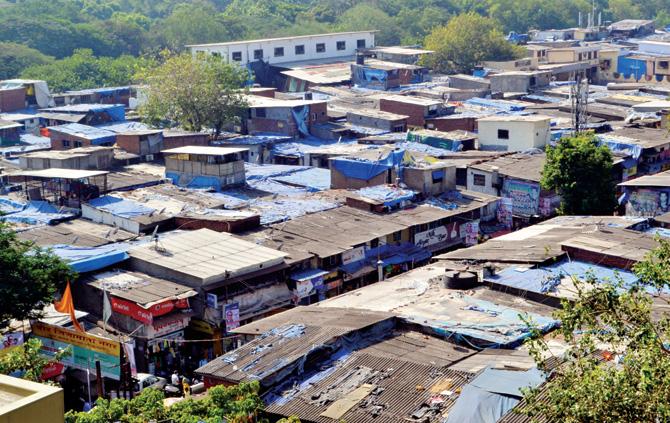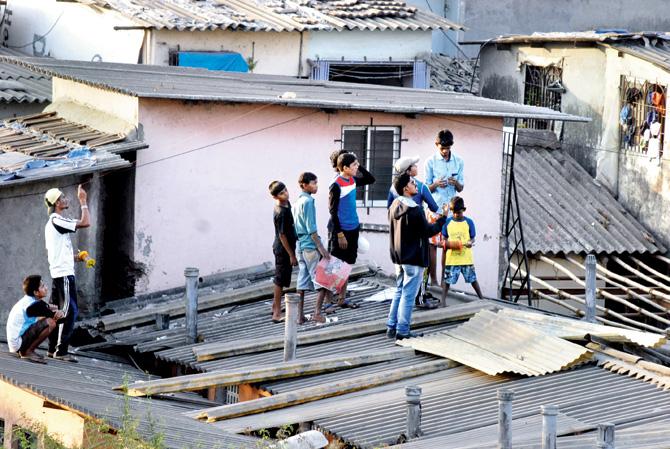With civic polls just a year away, corporators across party lines are all set to pass a proposal allowing height of post-1995 shanties to be increased from 14 feet to 18 feet

The BMC is all set to increase the permissible height of slums from 14 feet to 18 feet. The civic house will discuss “the desirability of giving permission to slums prior to 1995 to increase height” when it meets on December 14.
Read Story: Where did 20 lakh slum dwellers vanish from Mumbai?

The new permissible ceiling will almost double the number of shanties in each slum pocket. File pics
Sources across political parties told mid-day that the proposal will sail through without opposition. The BMC elections are just over 12 months away. Interestingly, the current height of 14 feet was set after corporators pushed a similar proposal through under the same circumstances in 2011 — one year before the previous BMC election.

Corporators say that some slums in the city already have higher floors, and that this law will help make up for the government’s failure to facilitate redevelopment
Before that, slums were only ground floor structures. The 2011 change allowed them to go up to ground-plus-one floor. If and when the current proposal passes, slums will be allowed to go up to ground-plus-two floors.
Also Read: State-of-the-art tech to rehab slum dwellers, counter mafia

mid-day is in possession of a copy of the agenda for the civic house meeting scheduled for December 14. While it is not known which corporator mooted the proposal, it has been listed under the head ‘resolutions of the improvements committee’.
When mid-day contacted the improvements committee chairman Prakash Gangadhare, a BJP corporator, he said he was not aware of the committee passing the proposal. However, it would become clear on December 14 who mooted it.
Corporators told mid-day that some slums in the city already have higher floors, and that this law will help make up for the government’s failure to facilitate redevelopment. They said this is only fair considering the growth in the city’s slum population.
Rais Shaikh, group leader of the Samajwadi Party in the BMC, said, “We are now discussing the height to be increased to 18 feet, when already many slums do have the shanties with this height. It is the need of the hour. A full generation has grown up but new homes haven’t been created. We will see to it that it passes,” said Shaikh.
According to the 2011 census, over 60 per cent of Mumbai’s population live in slums. A majority of these will be eligible to increase the height to 18 feet. Some prominent slums on BMC land include: Nargis Dutt Nagar in Bandra, Prem Nagar in Worli, Tulsiwadi in Tardeo, Jijamata Nagar in Worli, Baiganwadi in Govandi, and parts of Dharavi.
“The slum population is increasing and they cannot afford expensive houses available in market for crores. My party and me are fully supporting the proposal for height to be increased to 18 feet. This will enable the growing families to adjust in the same place,” said Gyanmurti Sharma, BJP corporator.
The ruling Shiv Sena, too, has endorsed the proposal. “This is a welcome move. But it should be ensured that if anyone constructs higher than 18 feet, then they will lose all benefits. Also, this should be the final cap. It should not go beyond that,” said Avkash Jadhav, Shiv Sena corporator.
Incidentally, both the Sena and the BJP had opposed the then Congress-NCP state government’s move to extend the cut-off for legitimate slums to 2000 just ahead of last year’s assembly elections. However, the only opposition to the current proposal seems to be from the bureaucracy. Even in the past, it was officials who stalled such populist proposals.
Congress Corporator Pravinder Bhamra, who had last year suggested that the height of slums be increased, claimed his proposal was scuttled due to opposition from the administration. “The then commissioner hadn’t supported the proposal and it didn’t go through,” Bhamra told mid-day.
Senior Officer from BMC’s Development Planning Department said, “Let the proposal come in the agenda, and let corporators support it. We do not endorse it, because, every time the height cannot be increased and vertical slums are not the answers to cater the growing slum population in the city.”
Concerns raised
For urban planners, the chief concern is whether the civic body has the bandwidth to ensure basic amenities for the increased population. Pankaj Joshi, executive director, Urban Design Research Institute, said while increasing the height is not a major problem, building suitable infrastructure to support this increased population is.
Also Read: BMC to permit construction of private toilets in slums
“The density of slums is increasing, and higher the slums more the people who will be accommodated,” said Joshi. “I am not opposed to the extension of height. When rich can stay in taller buildings, why can’t the poor? But then, proper amenities should be provided. Things like toilets inside the house, proper open spaces, and air and sunlight should be available.”
Another concern is that the decision will only end up aiding developers. Activists said increasing the height will enable builders to appropriate FSI to build more high-rises. Amit Maru, a slum rehabilitation activist, said builders will use the density of these slums to get more FSI for sale component flats when redeveloping the shanties.
“Right now under redevelopment, only the person who stays on the ground floor of a shanty gets a home,” said Maru. “But if the upper floors are legalised, then the builder will show density, will get higher FSI and other incentives to construct taller buildings for sale. Also, the BMC should clarify how many people will benefit when a slum is redeveloped. Is it going to be only the people on the ground floor, as it is currently, or will those in the higher floors also get a redeveloped flat?”
 Subscribe today by clicking the link and stay updated with the latest news!" Click here!
Subscribe today by clicking the link and stay updated with the latest news!" Click here!









